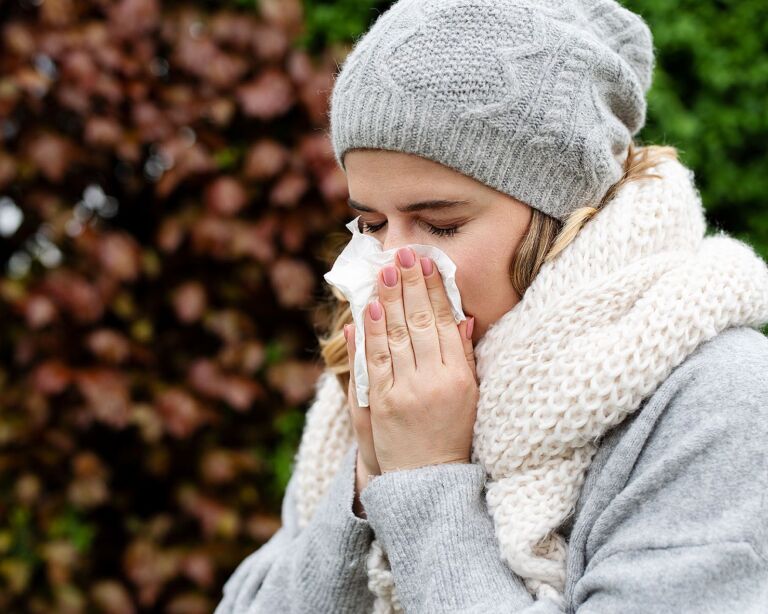A viral infection can be harmless, but sometimes life-threatening. It is therefore all the more important to recognize the infection quickly and to treat it specifically. Vaccination protects against certain viral diseases. In many cases, hygiene measures can prevent a viral infection and prevent its consequences.
Viral infectious diseases
Viral infections
Viral infectious diseases or viral infections include common viral diseases, such as respiratory infections (flu, colds), but also annually emerging dangerous viral infections such as SARS, MERS coronavirus or EBOLA, which can spread epidemically, i.e. across national borders.
Overview: What is a viral infection?
A viral infection is an infection (contagion) with viruses. This occurs when the pathogens enter the body through the injured skin, via food, droplet or smear infection and multiply there.
Unlike bacteria, viruses do not have their own cells or metabolism. Rather, they rely on other living cells to reproduce, which they use as hosts. This means they can only reproduce within these host cells. To do this, they dock onto a host cell and penetrate its protective envelope (cell membrane). They then introduce their genetic material into the cell and reprogram it so that the host cell begins to produce new viruses and release them. Viral replication can occur directly at the point of entry, such as the respiratory tract, or when the viruses have reached their target organ via the bloodstream, lymphatic system, or nerves.
A viral infection can cause various clinical pictures. Viral diseases significant to humans and their causative agents include:
- AIDS (HIV)
- COVID-19
- Yellow fever (togaviruses)
- Influenza (influenza viruses)
- Hepatitis (hepatitis viruses)
- Measles and mumps (paramyxoviruses)
- Smallpox (poxviruses)
- Poliomyelitis/polio (picornaviruses)
- Rubella (togaviruses)
- Chickenpox and zoster (herpes viruses)
Viral diseases can be acute, i.e. sudden and temporary, or chronic, i.e. permanent.
Viral infection – frequency and age
A viral infection can be the cause of a variety of diseases. Accordingly, no precise figures exist that cover all viral diseases in total. According to the Robert Koch Institute, however, influenza infections, for example, cause about 500 million cases of illness worldwide each year.
Viral diseases can occur at any age. However, some age groups are particularly severely affected by viral infection. For example, young children and the elderly with influenza are more likely to require hospitalization. In addition, the rate of deaths is higher in old age.
Viral infection: causes and risk factors
A viral infection does not automatically make you sick. Often our immune system can quickly and effectively fight certain viruses, such as cold viruses (rhinoviruses). Only when this fails can a viral infection lead to a viral infectious disease. Many viruses are highly infectious and spread rapidly from person to person. The current example is the Sars-CoV-2 virus (Corona virus). To make matters worse, many viruses are constantly changing. The body or the defense system often cannot react to this or cannot react quickly enough.
In general, people with an immune deficiency, a previous illness or poor medical care or lack of protective measures (vaccinations) are particularly at risk of contracting a viral infection.
Symptoms: Viral infection
A viral disease can result in certain symptoms, but can also be asymptomatic. For example, typical symptoms of a cold (flu-like infection) include a scratchy throat, runny nose, sneezing, cough, fatigue and possibly a slight fever. However, some viral diseases are also accompanied by severe symptoms such as high fever or can affect and damage organs:
- Infections of the gastrointestinal tract (e.g. gastroenteritis) caused by noroviruses or rotaviruses: diarrhea, vomiting, headache, abdominal pain and pain in the limbs
- Liver infections (hepatitis): nausea, vomiting, loss of appetite, fever, upper abdominal pain, joint or muscle pain, yellowing of the skin (jaundice).
- Infections of the nervous system or brain (e.g., rabies virus and West Nile virus): Fever, headache, fatigue, muscle pain, nausea, impaired consciousness (e.g., unconsciousness or confusion), impaired concentration and memory, seizures.
- Viral infections of the skin (such as warts or chickenpox): itchy, sometimes painful skin changes (thickening, redness, rashes)
Some viral infections, such as infections with the hepatitis B or hepatitis C virus, can be chronic. This means that the infection persists for years to decades. This can lead to permanent damage, such as severe scarring of the liver (cirrhosis), liver failure and sometimes liver cancer.
Viral infection: diagnosis with us
Often we receive already due to the symptoms and the clustered occurrence (for example, during a flu epidemic) Evidence of viral disease. Some viral infections also cause typical symptoms (such as the rash associated with measles, rubella, or chickenpox) that facilitate diagnosis. In some cases, blood tests and samples of blood or other body fluids also provide information about the type and intensity of the infection. To detect an infection with the Corona virus, medical personnel take a swab from the nose, mouth, throat area or the coughed-up secretion, for example. This is then examined in the laboratory for the virus.
For a definitive diagnosis, antibodies against the virus can also be detected. While IgM antibodies indicate a fresh infection, IgG antibodies indicate a chronic infection or pre-existing immunity. Certain pathogens can also lead to changes in the brain. In this case, imaging techniques such as computed tomography and magnetic resonance imaging may be used for diagnosis.
Viral infection: prevention, early detection, prognosis
A viral infectious disease cannot always be avoided. In many cases, however, preventive measures can prevent infection.
Viral infection: prevention through vaccination (immunization)
Vaccines exist against a number of viral diseases. Experts distinguish between two forms of immunization:
- Active immunization: In this process, the body is specifically confronted with the pathogen so that it forms specific defense substances (antibodies) against the virus. The vaccine is administered before exposure to the virus to prevent infection in the first place. The vaccines are attenuated (live vaccine) or killed (dead vaccine) before vaccination. Examples of live vaccines are those against measles, mumps and rubella. Vaccines against influenza, on the other hand, are mostly inactivated vaccines.
- Passive immunization: With passive immunization, the body receives ready-made antibodies against the pathogen. Such vaccination is usually given when a person has already been infected with the pathogen and there is no time left for active immunization. The advantage is that the injected antibodies act immediately. The disadvantage is that the organism gradually breaks down the foreign substances. As a result, the vaccination protection lasts only for a limited time. Example of passive form of immunization is vaccination against hepatitis B or rabies.
Viral infection: What you can do yourself to prevent it
You can prevent many viral diseases and thus protect yourself and others from infection. Which measures are appropriate in detail also depends on how the virus is transmitted. The following tips are especially useful:
- Wash your hands thoroughly with soap and water on a regular basis. Think also about the areas between the fingers, under the fingernails and wrists. Hand washing should last at least 20 seconds. This has been shown to reduce the risk of virus transmission and infection.
- Especially in countries with poor hygiene standards, “cook it, peel it, fry it or forget it” applies. In addition, you should avoid salads and other raw vegetables, ice cream and milk that has not been boiled. The same applies to tap water and ice cubes. Also be careful with dishes served lukewarm. When in doubt, dine à la carte rather than help yourself from the buffet.
- When blowing your nose, alternately hold one nostril closed and blow without much pressure (no trumpeting!). After blowing your nose, immediately dispose of the paper handkerchief (not a cloth handkerchief!) and wash your hands if possible. If you have to sneeze and do not have a handkerchief at hand, you should do so in the crook of your own arm.
- Make sure you take appropriate protective precautions during sexual intercourse – for example, by using a condom appropriately.
- Protect yourself from mosquitoes and ticks by wearing long clothing, mosquito nets and applying repellents – especially when staying in high-risk areas.
Course and prognosis of a viral infection
The course and prognosis of a viral disease depends not only on the type of pathogen, but also on the ability of the immune system to fight the virus. It is also important whether targeted treatment is given in time. However, despite modern medical possibilities, not all viral diseases are curable.


